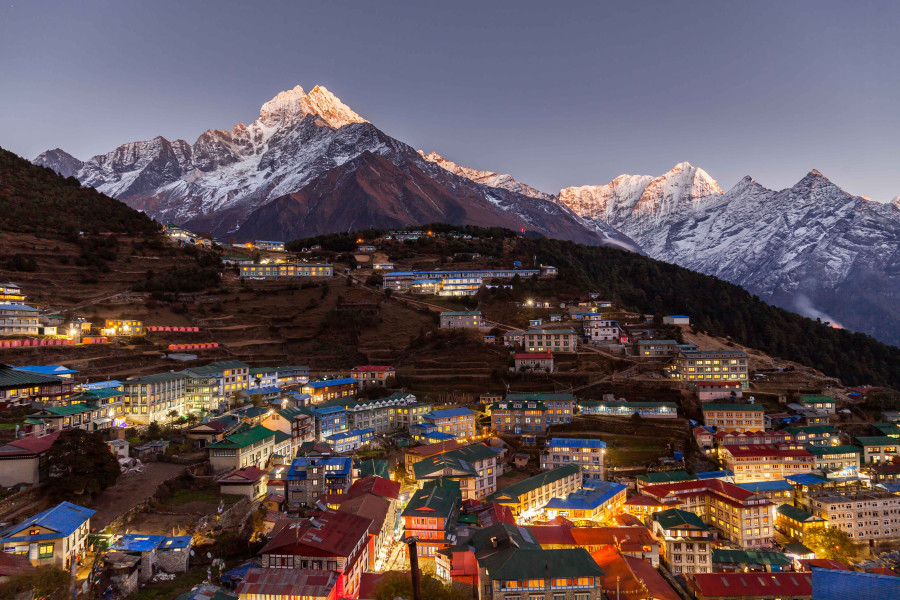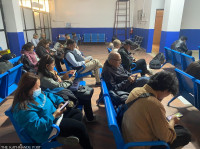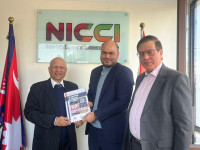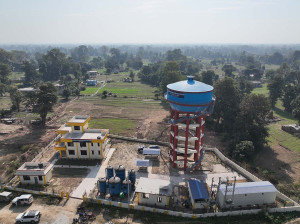Money
Come one, come all, says Everest region to tourists
The local administration has removed all Covid-related requirements including test report and quarantine for visitors.
Sangam Prasain
The local administration in Nepal's Everest region has thrown the door wide open to tourists by removing all Covid-related restrictions in a fresh attempt to woo back trekkers to its popular trails.
Since January 23, sightseers visiting the Everest region are no longer required to submit a negative Covid-19 RT-PCR test report or go into quarantine, Binod Bhattarai, chief administrative officer at Khumbu Pasang Lhamu Rural Municipality, told the Post.
“The government has lifted the lockdown fully, the rate of the spread of the virus has dropped, and Nepal is expected to begin an inoculation drive against infection this week,” said Bhattarai. “Based on all these factors, we deemed it necessary to lift the negative Covid-19 RT-PCR requirement to visit the Khumbu or Everest region.”
“However, if any travelling passengers are suspected to have developed Covid-19 symptoms, we have made arrangements to conduct antigen tests at Nicole Niquille Hospital in Lukla,” he said.
Bhattarai added that the rural municipality had imparted training in swab collection to health officials to facilitate testing of coronavirus infections also. The antigen test will cost Rs1,500. However, for local people who cannot afford quarantine costs, the municipality will foot the bill, said Bhattarai.
Nepal on Sunday recorded 270 new coronavirus cases. The overall infection tally has reached 269,450 with 3,312 active cases.
According to the Ministry of Health and Population, 264,137 infected people have recovered from the disease so far, 403 of them in the past 24 hours.
On September 17 when the government decided to allowed foreign tourists into Nepal for trekking and mountaineering from October 17, Khumbu Pasang Lhamu Rural Municipality had made it mandatory for all visitors, including Nepalis, to submit negative Covid-19 RT-PCR test reports not older than 72 hours before they are allowed entry.
Travellers arriving without a report by air or on foot were put into quarantine for 14 days at their expense which comes to Rs4,000 per day.
“There are no foreign tourists at this moment. But we are planning to draw some numbers this spring when the Everest climbing season begins in March,” said Bhattarai.
“Many hotels and trekking and expedition companies, including guides, are happy with the decision as they see no reason why foreigners should be kept away when all sectors are open,” said Bhattarai.
The Everest region is the second most popular trekking route in Nepal after Annapurna. In 2019, more than 57,000 thrill seekers walked over the trails there.
Khum Bahadur Subedi, president of the Trekking Agents Association Nepal, said that almost all trekking destinations in the country, including Langtang and Mustang, had lifted Covid-19 related restrictions for visitors, but the federal government still has several strict requirements in place that is keeping tourists away.
Nepal threw open the doors to foreign tourists in mid-December after keeping them out for nine months as the country battled the Covid-19 pandemic.
All tourist visas have been restored, and foreign visitors are now free to fly into the country, the Department of Immigration said, but the land borders are still closed.
According to the Department of Immigration, visitors above age five must have a negative PCR test obtained not more than 72 hours before departure. A mandatory seven-day hotel quarantine, with a second negative PCR test on the fifth day after arrival, is required. Trekkers and mountaineers must also have insurance coverage worth $5,000.
“All these requirements will discourage tourists,” said Subedi. “As we are expecting a partial recovery in tourist arrivals this spring, the government needs to be more proactive to resume tourism activities in a full fledged manner for the coming autumn season.”
Subedi said that the tourism industry had been severely hit as Nepal lost nearly a million tourists last year.
“For the industry to recover, we need the government to take a drastic step,” said Deepak Raj Joshi, former chief executive officer of the Nepal Tourism Board.
“If tourists who have been vaccinated against Covid-19 arrive in Nepal, why do we need to ask them for quarantine or PCR reports?” he said. “They can simply submit their vaccination certificate. Those who have not been vaccinated can produce a negative PCR report.”
The Seychelles has become the first country in the world to allow vaccinated tourists to enter the country without quarantine requirements, Joshi said.
Travellers who have been vaccinated against Covid-19 still need to maintain social distancing, but they will be allowed to visit the Indian Ocean archipelago without having to self-isolate upon arrival, he said.
The country began vaccinating its population earlier this month, rolling out the Sinopharm vaccine on January 10.
“The government has eased restrictions to some extent, but there are still hassles for tourists like obtaining on-arrival visas, which are not given at Tribhuvan International Airport,” said Joshi.
“The quarantine provision needs to be removed as vaccination against Covid-19 has begun globally, including Nepal,” said Joshi. “We don’t have to be strict, otherwise we will be a loser in the tourism industry.”
Visit Nepal 3.0 planned for 2020 had hoped to host 2 million tourists, but it ended up becoming the worst year for tourism since 1986.
The Covid-19 pandemic crisis resulted in an 80.78 percent drop in tourist arrivals from the previous year, making it the worst year-on-year decline since Nepal opened to the outside world in the 1950s.
In 1955, world-renowned tour operators Thomas Cook and Sons brought a group of 60 tourists to Nepal who were officially recognised as foreign tourists. Nepal started keeping records of foreign tourists since 1962.
According to the statistics of the Department of Immigration, Nepal received 230,085 foreign tourists last year, equivalent to the arrivals figure of 1986.
Most of them came before the country slapped restrictions on tourist entry on March 20. Between April and December, fewer than 15,000 individuals visited Nepal.
On March 12, 2020, the government decided to stop issuing on-arrival tourist visas to nationals of all countries besides cancelling spring mountaineering expeditions including those to Everest. The decision came a day after the World Health Organisation declared the Covid-19 outbreak a pandemic, and urged countries to take precautionary measures.
From October 17, Nepal opened the door a crack for trekkers and mountaineers, nearly seven months after the country imposed a complete lockdown.




 18.12°C Kathmandu
18.12°C Kathmandu













